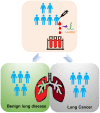The function of LncRNAs and their role in the prediction, diagnosis, and prognosis of lung cancer
- PMID: 33931980
- PMCID: PMC8021541
- DOI: 10.1002/ctm2.367
The function of LncRNAs and their role in the prediction, diagnosis, and prognosis of lung cancer
Abstract
Lung cancer remains a major threat to human health. Low dose CT scan (LDCT) has become the main method of early screening for lung cancer due to the low sensitivity of chest X-ray. However, LDCT not only has a high false positive rate, but also entails risks of overdiagnosis and cumulative radiation exposure. In addition, cumulative radiation by LDCT screening and subsequent follow-up can increase the risk of lung cancer. Many studies have shown that long noncoding RNAs (lncRNAs) remain stable in blood, and profiling of blood has the advantages of being noninvasive, readily accessible and inexpensive. Serum or plasma assay of lncRNAs in blood can be used as a novel detection method to assist LDCT while improving the accuracy of early lung cancer screening. LncRNAs can participate in the regulation of various biological processes. A large number of researches have reported that lncRNAs are key regulators involved in the progression of human cancers through multiple action models. Especially, some lncRNAs can affect various hallmarks of lung cancer. In addition to their diagnostic value, lncRNAs also possess promising potential in other clinical applications toward lung cancer. LncRNAs can be used as predictive markers for chemosensitivity, radiosensitivity, and sensitivity to epidermal growth factor receptor (EGFR)-targeted therapy, and as well markers of prognosis. Different lncRNAs have been implicated to regulate chemosensitivity, radiosensitivity, and sensitivity to EGFR-targeted therapy through diverse mechanisms. Although many challenges need to be addressed in the future, lncRNAs have bright prospects as an adjunct to radiographic methods in the clinical management of lung cancer.
Keywords: EGFR; LDCT; biomarker; chemosensitivity; diagnosis; lncRNA; lung cancer; predictive; prognosis; radiosensitivity.
© 2021 The Authors. Clinical and Translational Medicine published by John Wiley & Sons Australia, Ltd on behalf of Shanghai Institute of Clinical Bioinformatics.
Conflict of interest statement
The authors declare that there is no conflict of interest that could be perceived as prejudicing the impartiality of the research reported.
Figures








References
-
- Bray F, Ferlay J, Soerjomataram I, Siegel RL, Torre LA, Jemal A. Global cancer statistics 2018: GLOBOCAN estimates of incidence and mortality worldwide for 36 cancers in 185 countries. CA Cancer J Clin. 2018;68(6):394–424. - PubMed
-
- Cooper S, Spiro SG. Small cell lung cancer: treatment review. Respirology. 2006;11(3):241–248. - PubMed
-
- Zheng M. Classification and pathology of lung cancer. Surg Oncol Clin N Am. 2016;25(3):447–468. - PubMed
-
- Blanchon T, Brechot JM, Grenier PA, et al. Baseline results of the Depiscan study: a French randomized pilot trial of lung cancer screening comparing low dose CT scan (LDCT) and chest X‐ray (CXR). Lung Cancer. 2007;58(1):50–58. - PubMed
Publication types
MeSH terms
Substances
Grants and funding
LinkOut - more resources
Full Text Sources
Other Literature Sources
Medical
Research Materials
Miscellaneous
